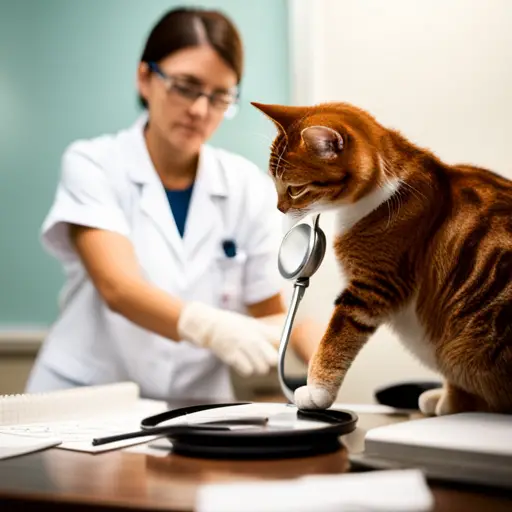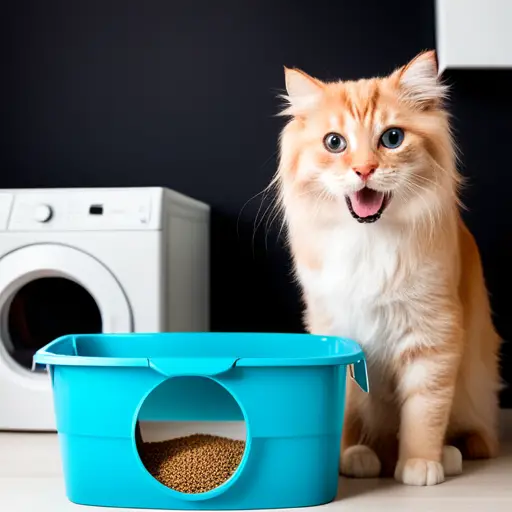Do you constantly clean up messes outside your cat’s litter box? Are you frustrated with the smell and the constant need to clean up after your furry friend? Don’t worry, you’re not alone. Many cat owners experience litter box problems with their pets, but the good news is that there are solutions.
This article will guide you through the steps to identify the problem behavior, rule out any medical issues, address environmental factors, use positive reinforcement, and seek professional help.
With our help, you can get your cat back on track and eliminate litter box problems.
Key Takeaways
- Identify the problem behavior and rule out any medical issues before fixing cat litter box problems.
- Address environmental factors like the cleanliness of the litter box, the type of litter used, and providing ample space and stimulation for the cat.
- Use positive reinforcement techniques like clicker training, verbal praise, playtime, and rewards for good behavior.
- Consider seeking professional help from a veterinarian or animal behaviorist, and communicate openly and honestly about the issue.
Identify the Problem Behavior

You’re probably feeling frustrated and overwhelmed with your cat’s litter box problems, but identifying the specific behavior causing the issue is the first step to fixing it.
Common triggers for litter box problems include a dirty litter box, a change in the type of litter, or a medical issue. Observe your cat’s behavior and note any changes in their routine or environment that may have triggered the problem.
Once you have identified the specific behavior causing the litter box problem, you can implement behavioral modification techniques. For example, if your cat avoids the litter box because it’s dirty, clean it regularly. If your cat is uncomfortable with the type of litter, try different types until you find the one they prefer.
If the problem persists, consult a veterinarian to rule out any medical issues. Remember, patience and consistency are key when modifying your cat’s behavior.
Rule Out Medical Issues

If your feline friend is exhibiting unusual behavior regarding their potty habits, it’s important to consider any potential underlying medical issues that may be at play.
Before you start thinking that your cat is just being stubborn or naughty, take them for a veterinary checkup to ensure that no physical health issues are causing it.
Common medical issues affecting litter box behavior include urinary tract infections, bladder stones, and kidney disease.
Once you’ve ruled out any medical issues, the next step is to consider dietary changes. Just like humans, cats can be sensitive to certain foods and ingredients. If you’ve recently changed your cat’s diet or started giving them new treats, it’s possible that this could be causing their litter box issues.
Talk to your vet about potential dietary changes or experiment with different types of litter to see if that helps. Taking a proactive approach can help your cat regain their normal, healthy potty habits.
| Pros | Cons |
|---|---|
| Veterinary checkup can identify underlying medical issues | Veterinary checkups can identify underlying medical issues |
| Dietary changes can help alleviate litter box problems | It may take time to find the right dietary solution for your cat |
| Experimenting with different types of litter can help find a solution | Your cat may be resistant to changes in their litter box routine |
Address Environmental Factors

To address environmental factors that may be affecting your feline friend’s potty habits, it’s important to create a comfortable and stress-free living space for them. This means providing them ample space to roam around and plenty of cozy spots to rest and relax.
You can create this space by placing comfortable bedding in various areas of your home and installing shelves or perches for your cat to climb and rest on. Providing stimulation for your cat can also help alleviate litter box problems.
Ensure to provide your cat with toys and scratching posts to keep them entertained and prevent them from feeling bored or anxious. You may also consider introducing interactive toys like puzzle feeders to keep your cat mentally stimulated and engaged.
By creating a comfortable and stimulating living space for your cat, you can help address any environmental factors contributing to their litter box problems.
Use Positive Reinforcement

Creating positive reinforcement for your feline friend can go a long way in improving their bathroom habits and overall behavior. Training techniques and reward systems can help your cat associate good behavior with positive outcomes. Here are some examples of positive reinforcement techniques you can use:
| Technique | Description | Reward |
|---|---|---|
| Clicker Training | Use a clicker to mark desired behavior and reward with treats | Treats |
| Verbal Praise | Use a positive and encouraging tone to praise good behavior | Affection |
| Play Time | Reward good behavior with play time and interactive toys | Play Time |
By using these techniques consistently, your cat will start to understand what behaviors are expected of them and will be more likely to repeat them. It’s important to remember to reward good behavior and not punish bad behavior, as punishment can cause fear and anxiety in your cat. With patience and consistency, positive reinforcement can be a highly effective tool in fixing litter box problems in your cat.
Seek Professional Help if Needed

Sometimes, even with consistent positive reinforcement, seeking professional help from a veterinarian or animal behaviorist can be necessary for addressing your feline friend’s bathroom habits and behavior.
Consulting veterinarians and behavioralists can help you identify the root cause of your cat’s litter box problem, whether medical or behavioral.
Finding reliable resources and professionals experienced in working with cats is important and can provide you with the necessary guidance and support.
When looking for a veterinarian or animal behaviorist, it’s important to research and finds someone with experience in dealing with litter box problems and cat behavior.
You can ask for recommendations from friends or family members who have cats, or you can search for reputable online forums and resources.
Once you find a professional, communicate openly and honestly about your cat’s behavior and provide them with as much information as possible.
With the right guidance and support, you can help your feline friend overcome their litter box problems and live a happy and healthy life.
Conclusion
So, you’ve identified the problem behavior, ruled out any medical issues, and addressed environmental factors, but your cat still has litter box problems. Don’t give up hope just yet! There are still a few more strategies you can try.
First, use positive reinforcement when your cat uses the litter box correctly. This can be as simple as giving them a treat or praise.
Secondly, if you’ve tried everything and your cat still isn’t using the litter box properly, seek professional help from a veterinarian or animal behaviorist.
With patience and persistence, you can help your cat overcome their litter box problems and enjoy a happy, healthy life.
